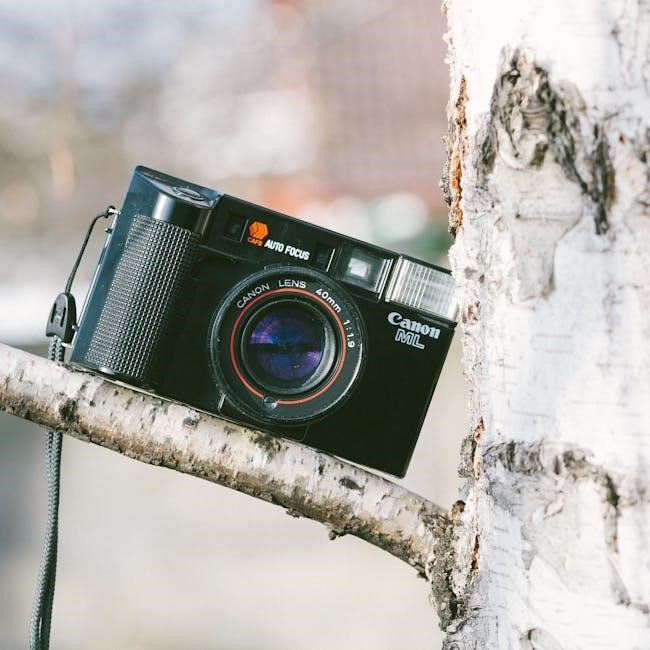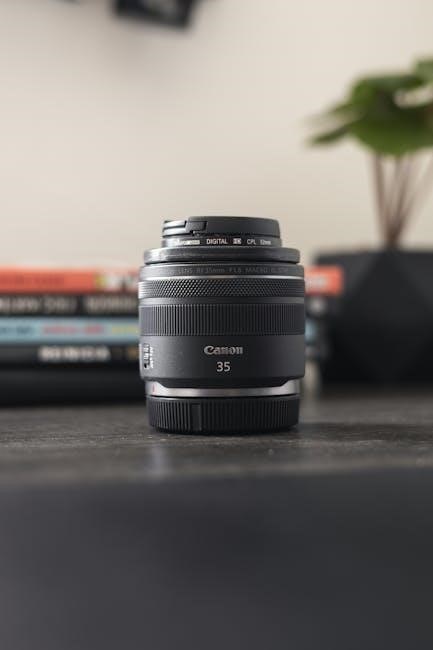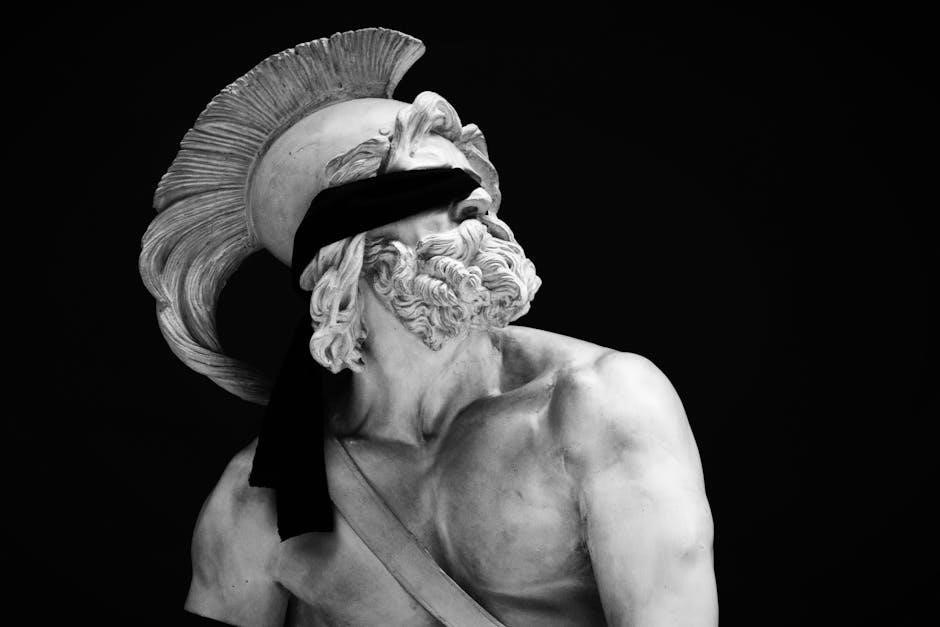The Canon EOS 80D is a versatile DSLR camera designed for both amateur and professional photographers‚ offering advanced features like a 24.2MP APS-C CMOS sensor‚ Dual Pixel AF‚ and improved connectivity options.
1.1 Overview of the Canon EOS 80D DSLR Camera
The Canon EOS 80D is a mid-range DSLR camera designed for enthusiasts and professionals‚ featuring a 24.2MP APS-C CMOS sensor and DIGIC 6 image processor. It offers improved image quality‚ faster autofocus‚ and enhanced video capabilities compared to its predecessor‚ the EOS 70D. The camera supports Dual Pixel AF for smooth focusing in video and Live View modes‚ along with a vari-angle touchscreen LCD for versatile shooting. Wireless connectivity options‚ including Wi-Fi and NFC‚ enable easy sharing and remote control. With a robust build and weather-sealing‚ the EOS 80D is ideal for capturing high-quality photos and videos in various conditions.
1.2 Key Features and Upgrades from the EOS 70D
The Canon EOS 80D introduces several upgrades over the EOS 70D‚ including a higher-resolution 24.2MP sensor for improved image quality and a faster DIGIC 6 processor for enhanced performance. It features a more advanced 45-point all-cross-type AF system for precise subject tracking and better low-light performance. The EOS 80D also offers improved video capabilities with Dual Pixel AF‚ enabling smooth and accurate focusing during recording. Additionally‚ it includes a built-in wireless connectivity option for seamless sharing and remote control‚ making it a more versatile and connected camera compared to its predecessor.

Accessing the Canon EOS 80D Instruction Manual
The Canon EOS 80D instruction manual is available as a downloadable PDF from Canon’s official website‚ offering detailed guides for both basic and advanced camera operations.
2.1 How to Download the PDF Manual
To download the Canon EOS 80D instruction manual‚ visit the official Canon website and navigate to the support section. Select the EOS 80D model and click on the “Manuals” tab. Choose the desired language and click the download link for the PDF manual. Save the file to your device and open it using a PDF reader. Ensure a stable internet connection for a smooth download process. The manual provides detailed instructions for camera setup‚ features‚ and troubleshooting‚ making it an essential resource for optimizing your camera’s performance.
2.2 Types of Manuals Available (Basic and Advanced)
Canon offers two types of manuals for the EOS 80D: the Basic Instruction Manual and the advanced‚ detailed Instruction Manual. The Basic Manual provides essential information for setting up and using the camera‚ covering fundamental features and operations. The advanced manual‚ available as a PDF‚ delves deeper into specialized settings‚ customization options‚ and technical details‚ ideal for experienced photographers. Both manuals are available for free download from the Canon website‚ ensuring users can access the level of guidance they need to maximize their camera’s capabilities.
2.3 Language Options and How to Change the Manual Language
The Canon EOS 80D manual is available in multiple languages to cater to global users. To change the manual language‚ navigate to the Setup menu (wrench icon)‚ select Setup 2‚ and choose the Language option. If the current language is unfamiliar‚ look for the icon resembling a face with a speech bubble. This feature ensures users can access instructions in their preferred language‚ enhancing ease of use. The process is straightforward and requires minimal navigation‚ making it accessible even for those less familiar with the camera’s menu system.

Understanding the Camera Layout
The Canon EOS 80D features an ergonomic design with intuitive controls‚ including a vari-angle touchscreen LCD‚ optical viewfinder‚ and strategically placed buttons for easy access to settings.
3.1 Exterior Components and Controls
The Canon EOS 80D features a robust exterior design with intuitive controls. The top panel includes a mode dial‚ ISO button‚ and shutter release‚ while the rear houses a vari-angle touchscreen LCD and navigation buttons. The optical viewfinder provides a clear view of the scene‚ and the lens mount supports EF-S lenses. Additional controls like the AF-ON button and front dial enhance operability. The camera’s weather-sealed body ensures durability‚ and the memory card slot is easily accessible. These components are strategically placed to allow quick access to settings‚ making it user-friendly for photographers of all skill levels.
3.2 Menu Navigation and Setup Options
The Canon EOS 80D features an intuitive menu system organized into multiple tabs for easy navigation. The Shoot tab allows adjustments like image quality and autofocus settings‚ while the Play tab manages playback options. The Setup tab includes camera maintenance and connectivity options‚ such as language selection. Users can customize settings to suit their preferences‚ with options to save personalized configurations. The menu also provides access to advanced features like wireless connectivity and firmware updates. Clear labeling and logical organization make it easy to navigate and configure the camera to meet individual needs‚ ensuring efficient operation for photographers of all levels.

Configuring the Canon EOS 80D
The Canon EOS 80D offers straightforward initial setup and customization options‚ allowing users to tailor settings like image quality‚ autofocus‚ and connectivity to suit their preferences and shooting style.
4.1 Initial Setup and Basic Configuration
Setting up your Canon EOS 80D for the first time involves a few straightforward steps. Start by turning on the camera and navigating through the menu to select your preferred language and set the date and time. Next‚ configure basic settings such as image quality‚ autofocus mode‚ and ISO sensitivity. The camera’s menu system is intuitive‚ allowing you to customize settings to match your shooting style. For a seamless experience‚ refer to the instruction manual‚ which provides detailed guidance on initial setup and troubleshooting common issues. This ensures your camera is optimized for its first use and beyond.
4.2 Customizing Settings for Personal Preference
The Canon EOS 80D allows you to tailor settings to your shooting style‚ enhancing your photography experience. Customize button functions‚ such as assigning the AF and DOF preview buttons to suit your workflow. Create custom shooting modes (C1-C3) to save frequently used settings for quick access. Additionally‚ you can personalize the menu by registering often-used items in the My Menu tab. These features ensure the camera adapts to your preferences‚ streamlining operations and improving efficiency during shoots. Customization options empower you to work intuitively‚ making the EOS 80D a flexible tool for diverse photographic needs and preferences.

Shooting Modes and Settings
The Canon EOS 80D offers various shooting modes‚ including Scene Intelligent Auto‚ Manual‚ Aperture Priority‚ and Shutter Priority‚ allowing customization for personal preference and advanced features like Dual Pixel AF for precise focusing in video and live view.
5.1 Auto Mode and Scene Intelligent Auto
The Canon EOS 80D features an intuitive Auto Mode designed for effortless photography‚ automatically adjusting settings like aperture‚ shutter speed‚ and ISO for optimal results. Scene Intelligent Auto further enhances this by analyzing the scene and refining settings to capture the best possible image. These modes are ideal for beginners or for quick shooting scenarios‚ ensuring sharp focus and balanced exposure without manual adjustments. The camera also detects faces and prioritizes them‚ making it perfect for portraits or group shots. With Auto Mode and Scene Intelligent Auto‚ users can focus on composition while the camera handles technical details.
5.2 Manual Mode (M) for Advanced Control
Manual Mode (M) on the Canon EOS 80D offers complete creative control‚ allowing users to independently adjust aperture‚ shutter speed‚ and ISO. This mode is ideal for advanced photographers who want precise control over their shots. By setting the mode dial to M‚ users can manually select settings to achieve specific effects‚ such as shallow depth of field or motion blur. The camera provides helpful tools like the electronic level and exposure compensation to assist in fine-tuning settings. Manual Mode is particularly useful in challenging lighting conditions or when a specific artistic style is desired. It empowers photographers to push their creativity and technical skills to the next level.
5.3 Aperture Priority (Av) and Shutter Priority (Tv) Modes
Aperture Priority (Av) and Shutter Priority (Tv) modes on the Canon EOS 80D provide a balance between automation and manual control. In Av mode‚ users set the aperture‚ and the camera adjusts the shutter speed for proper exposure‚ ideal for controlling depth of field. Tv mode allows setting the shutter speed‚ with the camera adjusting the aperture‚ perfect for capturing motion effects like freezing or blurring. Both modes offer exposure compensation‚ enabling fine-tuning of brightness. These semi-manual modes are versatile‚ catering to photographers who want creative control without managing all settings‚ making them excellent for various shooting scenarios and lighting conditions. They enhance flexibility while simplifying complex adjustments.

Autofocus and Manual Focus
The Canon EOS 80D features advanced autofocus with Dual Pixel AF for smooth video and Live View focusing. Manual focus allows precise control‚ while customizable AF settings enhance performance for various shooting scenarios.
6.1 Single-Point AF and Manual Selection
The Canon EOS 80D’s Single-Point AF allows precise subject selection‚ with manual focus offering full control for creative shots. Users can manually select focus points‚ ensuring sharpness exactly where needed‚ ideal for portraits or macro photography. This feature enhances flexibility‚ enabling photographers to override automatic settings for specific compositions. The combination of advanced AF and manual options provides a robust system for capturing images with professional-grade clarity and precision.
6.2 Using Dual Pixel AF for Video and Live View
Dual Pixel AF on the Canon EOS 80D enables fast and smooth autofocus during video recording and Live View shooting. This technology splits pixels into two‚ allowing for precise phase-detection autofocus. It reduces noise and delivers accurate subject tracking‚ making it ideal for dynamic video content. When using Live View‚ Dual Pixel AF ensures sharp focus acquisition‚ even with moving subjects. This feature is particularly useful for vloggers and videographers‚ as it maintains focus seamlessly‚ enhancing the overall quality of video production. The system operates quietly‚ minimizing distractions during recording sessions.
6.3 Adjusting Autofocus Settings for Optimal Performance
The Canon EOS 80D offers customizable autofocus settings to enhance performance. In the AF menu‚ you can adjust tracking sensitivity‚ acceleration/deceleration‚ and AF point selection. These settings help tailor autofocus behavior to your subject‚ such as fast-moving objects or stationary portraits. For video‚ adjusting the Movie Servo AF speed ensures smooth transitions. Additionally‚ using AF Case Studies (e.g.‚ for sports or erratically moving subjects) optimizes tracking. Enable AF Microadjustment for lens-specific calibration. Experiment with different configurations to achieve precise focus in various shooting scenarios‚ ensuring sharp results consistently.

Image Quality and Storage
The Canon EOS 80D delivers high-quality images with its 24.2MP APS-C CMOS sensor‚ supporting RAW and JPEG formats. It offers flexible storage options with dual memory card slots for efficient file management and backup.
7.1 RAW vs. JPEG: Understanding File Formats
The Canon EOS 80D allows capturing images in both RAW and JPEG formats. RAW files store uncompressed data‚ offering greater flexibility in post-processing‚ while JPEG files are compressed for smaller sizes and immediate use. RAW is ideal for professional editing‚ capturing maximum detail‚ and correcting exposure. JPEG is convenient for sharing and ensures compatibility across devices. The EOS 80D supports simultaneous recording of RAW and JPEG files‚ providing versatility for photographers. Understanding these formats helps optimize storage and workflow‚ ensuring the best results for your photography needs.
7.2 Configuring Image Quality Settings
The Canon EOS 80D offers customizable image quality settings to suit your photography needs. Access these options via the camera’s menu system under the Image Quality section. You can choose between RAW‚ JPEG‚ or simultaneous RAW+JPEG capture. For JPEG‚ select from Fine or Standard compression levels to balance file size and quality. Additionally‚ adjust settings like color space (sRGB or Adobe RGB) and noise reduction to enhance image output. The EOS 80D also allows you to set sharpness‚ contrast‚ and saturation levels‚ enabling precise control over your photos. These configurations ensure your images meet your creative and technical requirements‚ whether for professional editing or sharing.
7.3 Managing Memory Cards and Storage Options
Effectively managing memory cards and storage options is crucial for capturing high-quality images with your Canon EOS 80D. Always format your memory cards in the camera to ensure compatibility and optimal performance. Choose the appropriate card capacity based on your shooting needs‚ especially when using RAW or video modes. Regularly back up your files to prevent data loss. The EOS 80D supports multiple card slots‚ allowing you to store images separately or mirror them for redundancy. Use high-speed memory cards to avoid buffering delays during continuous shooting. Properly eject cards and maintain a consistent file organization system for efficient storage and retrieval.

Video Recording and Wireless Functionality
The Canon EOS 80D excels in video recording with manual controls for precise adjustments. Its wireless functionality enables seamless file sharing and remote camera operation via smartphone apps.
8.1 Shooting Video with the Canon EOS 80D
The Canon EOS 80D is well-suited for video recording‚ offering manual controls for aperture‚ shutter speed‚ and ISO. It supports high-quality MP4 format and features Dual Pixel AF for smooth focus transitions. The camera allows for precise adjustments‚ enabling filmmakers to capture professional-grade footage. For optimal results‚ users can enable manual focus to minimize lens noise during recording. The EOS 80D also supports external microphone input for enhanced audio quality. Its vari-angle touchscreen LCD simplifies framing and focusing‚ making it a versatile tool for both beginners and advanced videographers.
8.2 Wireless Functions and Connectivity Options
The Canon EOS 80D offers robust wireless connectivity‚ including Wi-Fi and NFC‚ enabling seamless image transfer to compatible devices. Users can remotely shoot photos and videos using the Camera Connect app‚ enhancing creativity and convenience. Bluetooth Low Energy (BLE) is also supported‚ allowing constant connection with smartphones for geotagging and automatic image transfer. These features make sharing content effortless and streamline workflows for photographers on the go. The wireless functions are detailed in the manual‚ providing step-by-step guidance for setup and usage.

Maintenance and Troubleshooting
Regular maintenance is crucial for optimal performance. Clean the camera and lens regularly to prevent damage. Refer to the manual for solutions to common issues.
9.1 Cleaning the Camera and Lens
Regular cleaning is essential to maintain the Canon EOS 80D’s performance. Use a soft‚ dry cloth to wipe the camera’s exterior and lens. For stubborn marks‚ dampen the cloth slightly with distilled water. Avoid harsh chemicals or abrasive materials. For the lens‚ use a microfiber cloth and a reputable cleaning solution. Gently wipe in a circular motion‚ starting from the center. Clean the LCD screen with a microfiber cloth‚ avoiding direct contact with the surface. Never touch the optical viewfinder or sensor with bare hands. Use a rain cover in wet conditions and store the camera in a dry‚ cool place to prevent dust buildup.
9.2 Common Issues and Solutions
Common issues with the Canon EOS 80D include error messages‚ lens malfunctions‚ and connectivity problems. For error messages like “Err 01‚” restart the camera or update the firmware. Lens issues‚ such as autofocus failure‚ may require cleaning the lens or re-registering it. Connectivity problems‚ like wireless transfer failures‚ can be resolved by resetting network settings or using the Canon Connect app. Battery life concerns can be addressed by disabling unnecessary features like GPS and reducing screen brightness. For persistent issues‚ refer to the Canon support website or contact customer service for professional assistance.

Additional Resources
Explore Canon’s official support website for downloads‚ firmware updates‚ and troubleshooting guides. User communities and forums also offer tips and solutions for optimizing your EOS 80D experience.
10.1 Canon Support and Downloads
Canon’s official website provides comprehensive support for the EOS 80D‚ including downloadable manuals‚ firmware updates‚ and drivers. Users can access troubleshooting guides‚ software tools like EOS Utility‚ and technical support resources. The site also offers detailed instructions for maintaining and optimizing camera performance. Additionally‚ Canon’s Auto Replenishment Service ensures timely delivery of supplies‚ while user guides and promotional materials are available for deeper exploration of the camera’s capabilities. Regular updates and support documents help users stay informed and enhance their photography experience with the EOS 80D.
10.2 User Guides and Communities
Canon EOS 80D users can benefit from a wealth of resources beyond official manuals. Online forums‚ tutorials‚ and photography communities offer tips‚ tricks‚ and troubleshooting advice. Websites like ManualOwl and HelpOwl provide easy access to user guides and FAQs. Additionally‚ Canon’s community forums and social media groups connect photographers‚ fostering knowledge sharing and creative inspiration. These platforms are invaluable for mastering the EOS 80D’s features and staying updated on best practices. Whether you’re a novice or an expert‚ these resources enhance your photography journey and help you make the most of your camera’s capabilities.

